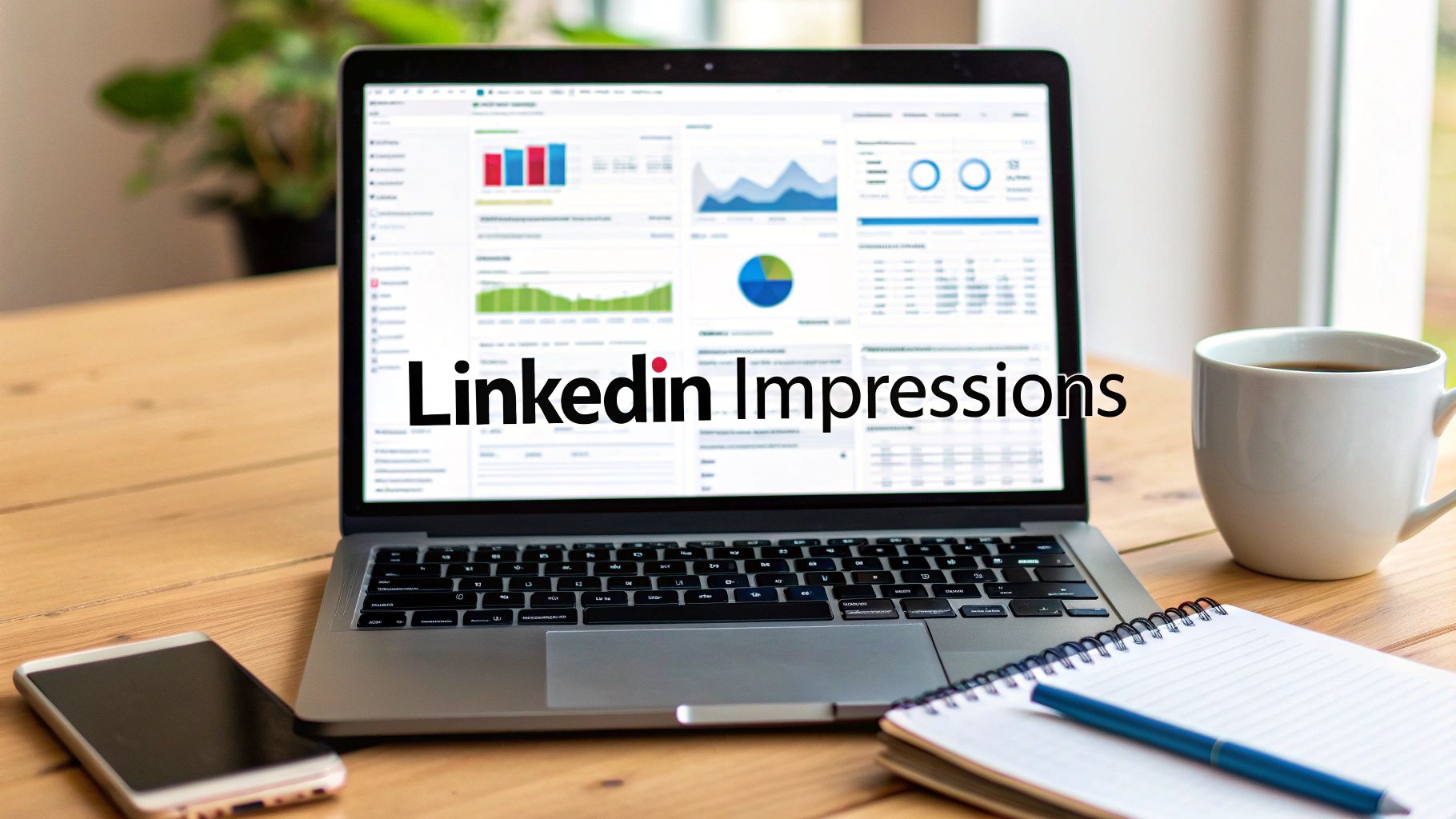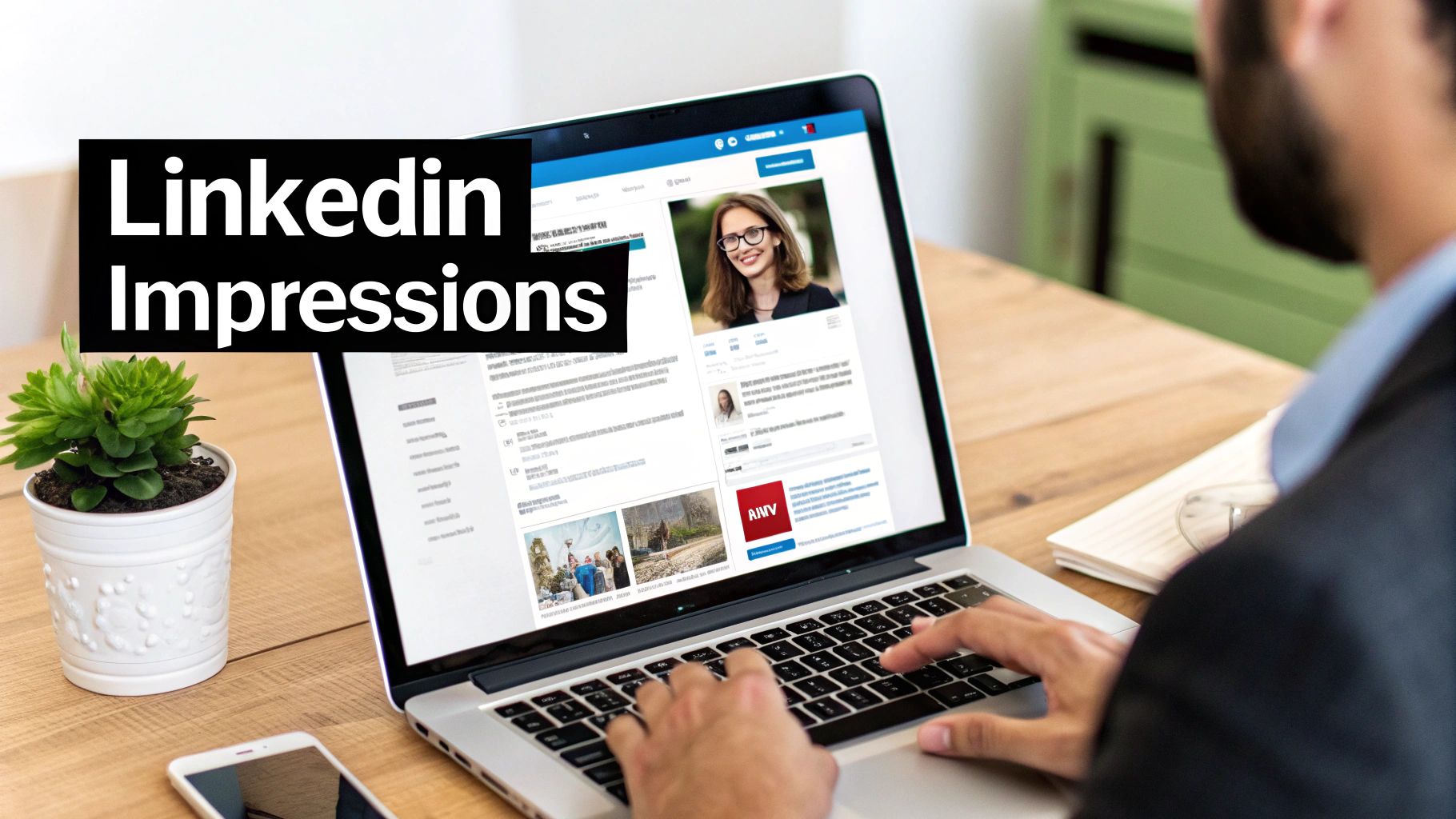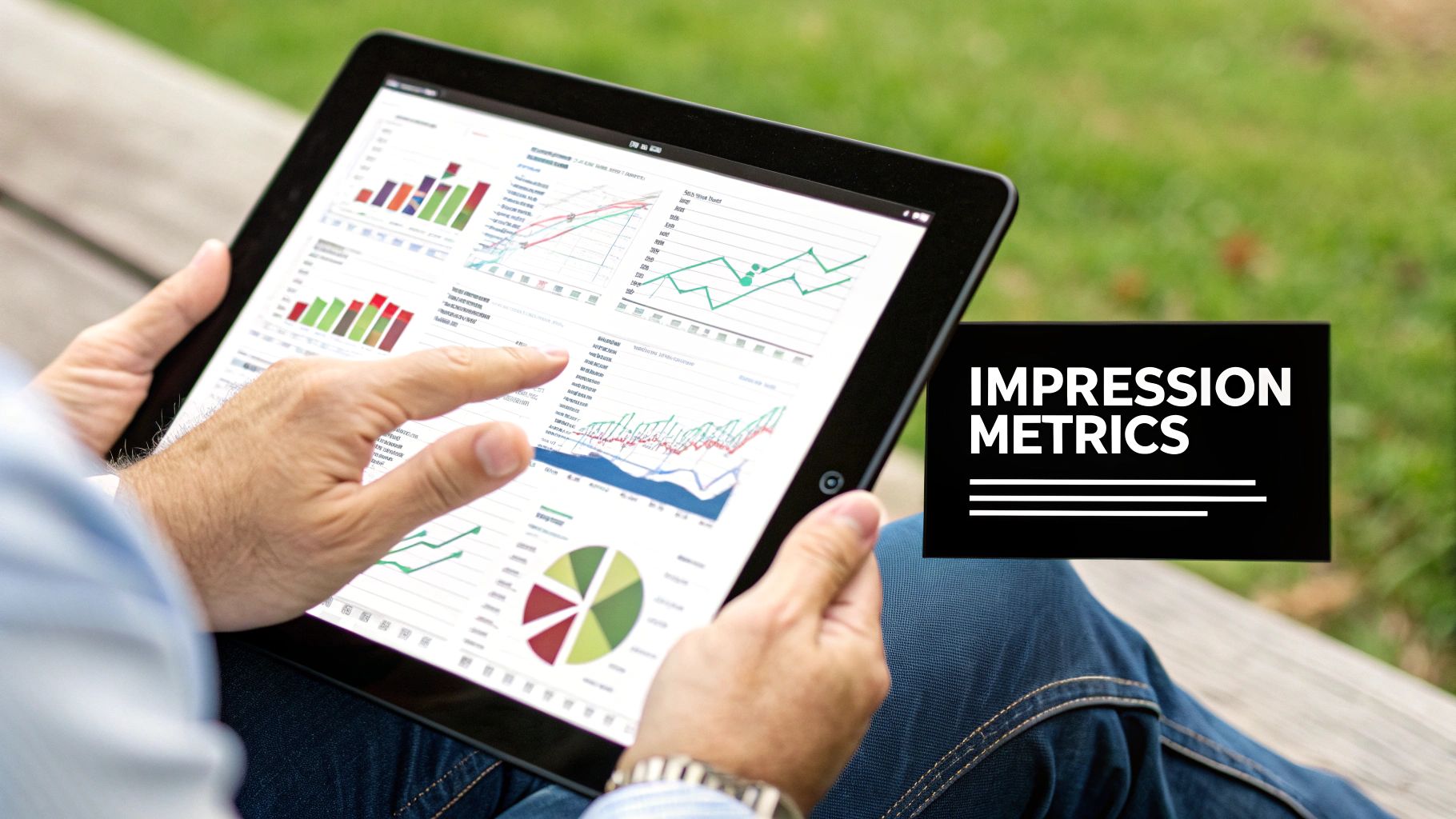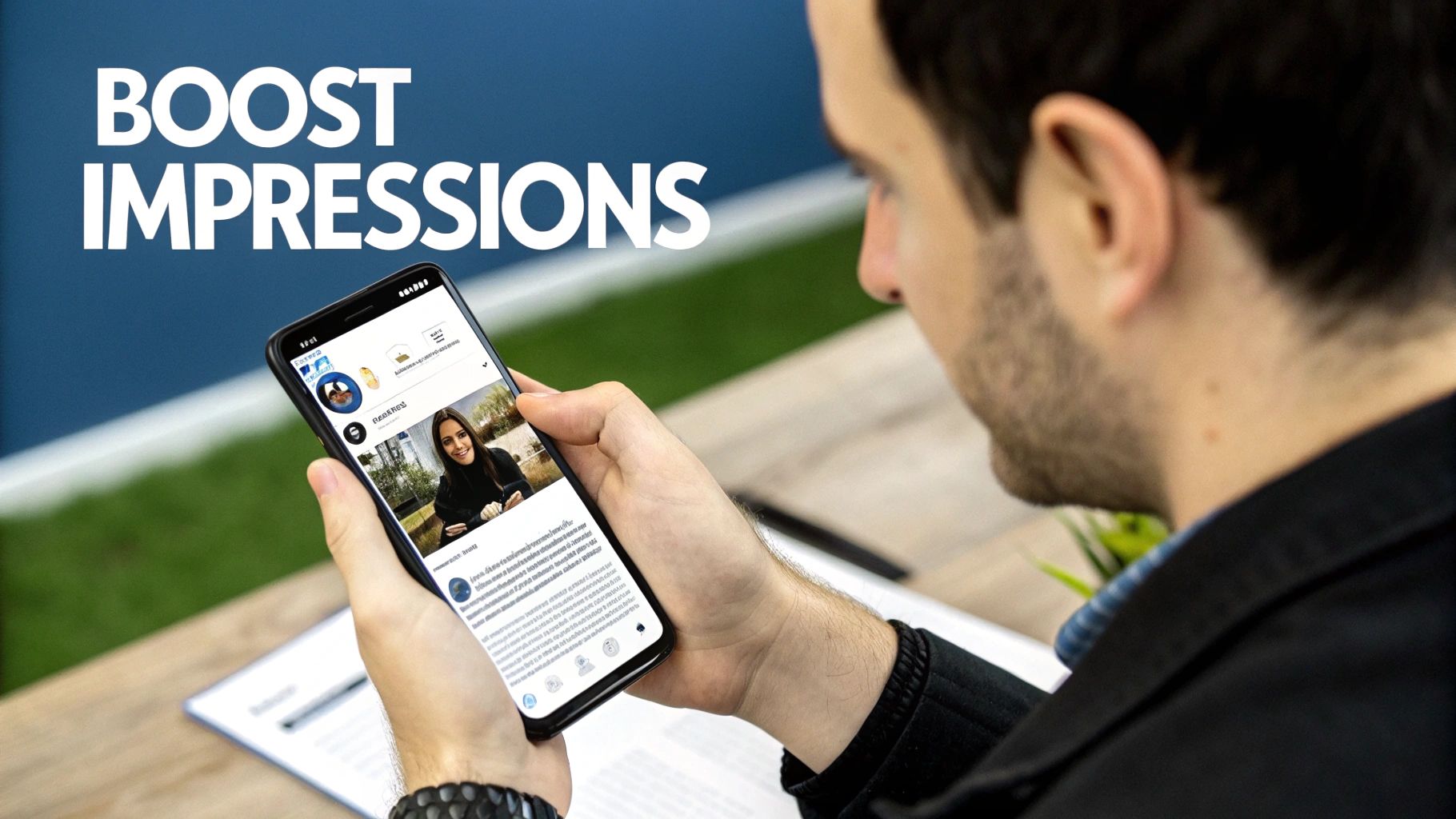
What Are Impressions on LinkedIn? Full Guide for Success
Published on 2025-06-05
Understanding What Are Impressions on LinkedIn

Let's break down what impressions on LinkedIn really mean. Simply put, an impression is the number of times your content is displayed in someone's feed. This includes posts, articles, and even your profile. Each time your content pops up on a user's screen, that's an impression, regardless of whether they interact with it. Think of it as a measure of your content's potential reach.
It's important to distinguish impressions from other metrics like views, clicks, or engagement. These represent more direct interactions with your content. Understanding this difference is key to accurately assessing your performance on LinkedIn.
Different Types of Impressions
To fully grasp the concept of LinkedIn impressions, it's helpful to understand the various types. These categories offer a more detailed look at how your content reaches your audience. LinkedIn impressions generally fall into three main categories:
Organic Impressions: These happen when your content is shown to your network and beyond based on LinkedIn's algorithm. It's the natural reach you get without paid promotion. Factors like content relevance, engagement from your network, and using relevant hashtags can significantly impact organic impressions.
Paid Impressions: These come from sponsored content campaigns. You pay to boost your posts' visibility to a larger, targeted audience. Paid impressions help you reach professionals outside your existing network, extending your content's reach to specific demographics and industries.
Viral Impressions: These occur when others share your content organically, amplifying its reach beyond your direct connections. A viral post can significantly increase your impressions. High engagement (likes, comments, and shares) fuels viral impressions.
Understanding these different types lets you tailor your LinkedIn content strategy for better results. Organic reach, paid promotion, and viral sharing all contribute to your overall impression count.
The Significance of Impressions
Impressions aren't just vanity metrics. They give you a glimpse into how widely your content is distributed. A higher impression count often means greater visibility. However, it's important to remember that impressions alone don't guarantee engagement or positive business results.
For example, many impressions with low engagement could signal that your content isn't resonating with your intended audience. Pairing impressions with engagement metrics gives you a clearer picture of what truly connects with your audience.
LinkedIn’s vast user base makes impressions especially impactful. As of January 2025, LinkedIn boasts over 1.2 billion members globally, making it a powerhouse for professional networking and marketing. This huge user base translates into significant impression potential.
To illustrate the platform's scale: LinkedIn sees roughly 1.77 billion monthly visits, with users spending an average of 48 hours per month on the platform via mobile. With over 69 million registered companies and 43% of consumers having a LinkedIn profile, the platform's reach is undeniable. For more detailed statistics: Discover more insights about LinkedIn usage.
Measuring and Interpreting Impressions
LinkedIn provides analytics tools to track your impressions for individual posts, articles, and your profile. You can access this data directly through your LinkedIn dashboard. By monitoring these metrics, you gain valuable insights into which posts perform well and which fall flat.
Analyzing this data, along with engagement metrics, helps you understand what kind of content grabs attention and sparks interest. This allows you to refine your content strategy based on real data, leading to more effective engagement on LinkedIn.
How LinkedIn Impressions Drive Professional Growth
LinkedIn impressions are more than just a vanity metric. They're a vital indicator of your content's reach and potential impact. Consistent impression growth can unlock tangible career opportunities, from new job offers to speaking engagements and strategic partnerships. Understanding how to leverage impressions is key for professional advancement.
The Compounding Effect of Impressions
Think of LinkedIn impressions as ripples in a pond. Each time your content is displayed, it creates an outward ripple. As you gain more impressions, these ripples overlap and amplify, creating a compounding effect. This makes future content exponentially more visible to your target audience.
For example, a post with a high number of impressions is more likely to be shown to a wider audience later on. This increased visibility can lead to more engagement, further amplifying your reach. It's a cycle of growth that begins with a single impression.
Leveraging Impressions for Career Advancement
Impressions provide valuable insights into what resonates with industry decision-makers. By analyzing which content generates the most impressions, you can identify trends and topics that grab their attention. This allows you to tailor future content, increasing your chances of being noticed and making valuable connections.
Consider a software developer consistently sharing insightful posts about new coding techniques. As their impressions grow, they become more visible to recruiters and potential employers seeking those specific skills. This increased visibility can translate directly into career opportunities.
The Psychology Behind LinkedIn’s Algorithm
LinkedIn’s algorithm favors engaging content. Higher impressions signal to the algorithm that your content is valuable and worth showing to more people. Focusing on creating engaging content is crucial for driving impression growth and maximizing reach. You might be interested in: How to monetize LinkedIn.
Tracking Impressions for Real-World Outcomes
To truly leverage impressions, track how impression growth translates into real-world professional outcomes. This involves monitoring metrics like connection requests, profile views, and messages. By correlating these with your impression data, you'll gain a clearer understanding of how your LinkedIn activity contributes to your career goals.
For instance, if you see increased connection requests after a post receives many impressions, it suggests your content is attracting the right attention and generating valuable leads.
Maximizing Your Impression Potential
Here are key strategies for maximizing your LinkedIn impression potential:
- Consistent Posting: Regular posting keeps your content fresh for your connections.
- Engaging Content Formats: Experiment with videos, polls, and articles.
- Strategic Hashtag Usage: Use relevant hashtags to expand your reach.
- Active Engagement: Interact with other users’ content to increase visibility and build relationships.
By focusing on these strategies, you can transform LinkedIn impressions from a simple metric into a powerful engine for professional growth. By understanding how impressions work and how to leverage them, you can unlock new opportunities and advance your career. Remember, consistent effort and a focus on providing value are essential for long-term success on LinkedIn.
Finding Your LinkedIn Impression Analytics Dashboard
Understanding how your content performs on LinkedIn starts with knowing where to find your impression data. This guide will walk you through locating your analytics dashboard and understanding its key features. Let's dive in and uncover the insights that many professionals miss.
Accessing Your Analytics
Whether you need data for your personal profile or a company page, accessing your LinkedIn analytics is easy. For personal profiles, simply click on your profile picture, then select "View Profile." You’ll see the "Analytics" option right below your introduction.
For company pages, go to your company page and click "Analytics" in the menu bar. This opens a comprehensive dashboard showcasing your key metrics.

Understanding The Dashboard
Your analytics dashboard contains a lot of information. One key difference to understand is between unique impressions and total impressions. Unique impressions represent the number of individual LinkedIn members who viewed your content. Total impressions count every time your content is displayed, even if it's to the same person multiple times.
Another important distinction is between organic impressions and paid impressions. Organic impressions come from your content’s natural reach, while paid impressions come from sponsored content campaigns. Understanding this difference helps you see which strategies are performing best.
The dashboard also offers demographic data. This helps you understand who's interacting with your content. You can then refine your content strategy based on this data to better reach your ideal audience.
Analyzing Post Performance
Want to see impression data for specific posts? Go to the "Posts" section of the analytics dashboard. There, you'll see a breakdown of each post's performance, including impressions, clicks, and engagement. This is invaluable for understanding what content your audience responds to best.
Advanced Techniques and Data Export
To get even more detailed insights, LinkedIn lets you export your data. This allows you to analyze trends, build custom reports, and combine your LinkedIn data with other marketing tools.
The table below summarizes the key impression metrics available within the LinkedIn Analytics dashboard:
To help you navigate the dashboard, here’s a quick guide:
LinkedIn Analytics Dashboard: Where to Find Key Impression Metrics
| Metric Type | Location in Dashboard | Data Frequency | Best Use Case |
|---|---|---|---|
| Post Impressions | Posts Section | Per Post | Analyzing individual post performance |
| Profile Impressions | Profile Overview | Daily/Weekly | Tracking overall profile visibility |
| Unique vs. Total Impressions | Post and Profile Sections | Per Post/Overall | Understanding audience reach and repeat views |
| Organic vs. Paid Impressions | Post and Campaign Sections | Per Post/Campaign | Evaluating content strategy effectiveness |
| Demographic Breakdown | Post and Profile Sections | Per Post/Overall | Identifying target audience characteristics |
By understanding these aspects of LinkedIn’s analytics, you can refine your content strategy and grow your professional presence. Regularly reviewing and analyzing your impression data is key to improving your LinkedIn performance.
Optimizing Content For Maximum LinkedIn Impressions

Now that you know where to find your impression data, let's talk about how to improve those numbers. Boosting your LinkedIn content for maximum impressions takes a strategic approach. It all comes down to understanding your audience and creating content that connects with them.
Understanding Your Audience
Before getting into specific strategies, remember that relevance is key. LinkedIn's algorithm prioritizes content that matches users' interests and professional network. This means understanding your target audience is essential. Think about their challenges and the information they're looking for. Answering these questions will guide your content creation.
Content Formats That Drive Impressions
Different content formats perform differently on LinkedIn. Text posts are important, but adding visual content like images and videos can significantly increase impressions. Visuals are more engaging, grabbing attention as users scroll through their feeds. Also, consider using LinkedIn's built-in features like polls and documents. These interactive formats encourage engagement, boosting visibility and impressions.
Hashtags: Expanding Your Reach
Hashtags are essential for making your content easier to find. But using too many or irrelevant hashtags can be counterproductive. Focus on a few relevant hashtags that match your content and target audience. This targeted approach ensures your content reaches the right people.
The Power of Engagement
Engagement is vital on LinkedIn. Posts with high engagement (likes, comments, and shares) tell the algorithm that the content is valuable. This leads to greater organic reach and more impressions. Encourage engagement by asking thought-provoking questions, replying to comments, and actively participating in industry discussions.
Crafting Compelling Opening Lines
The first few lines of your post are crucial for grabbing attention. They determine whether someone will stop scrolling and read more. Create compelling opening lines that spark curiosity, offer valuable insight, or pose a relevant question. This will draw readers in and increase engagement, leading to more impressions.
Timing Your Posts Strategically
When you post matters. Posting when your target audience is most active can significantly impact your impressions. Experiment with different posting times to find what works best. You might find this article helpful: How to master LinkedIn posting schedules. Also, consider your audience's demographics. As of February 2025, 56.9% of LinkedIn users were male, and 43.1% were female. The United States has the largest number of LinkedIn users (approximately 234 million), followed by Europe with over 304 million users. Understanding these demographics helps tailor your content and posting schedule. Find more detailed statistics here: Explore LinkedIn demographics.
Leveraging LinkedIn's Native Features
LinkedIn offers features designed to increase organic reach. Use features like LinkedIn articles, newsletters, and live videos to reach a wider audience and boost impressions. These features offer opportunities to demonstrate your expertise and connect with your network in meaningful ways.
Measuring and Analyzing Your Results
Finally, consistently track and analyze your impression data. Use LinkedIn's analytics dashboard to monitor your progress and identify trends. This data-driven approach helps refine your content strategy and optimize for maximum impressions. Consistency is key for long-term success on LinkedIn.
Converting LinkedIn Impressions Into Business Results
LinkedIn impressions are a valuable metric. But they're just the first step. The real value lies in turning those impressions into tangible business results. This means moving beyond simply being seen. You need to actively engage your audience and guide them towards taking action.
Bridging the Gap Between Impressions and Conversions
Converting LinkedIn impressions starts with understanding the customer journey. Map out the steps a potential customer takes, from their first encounter with your content (the impression) to a final sale or desired outcome. Each touchpoint – from profile visits to website clicks – offers valuable data you can use to optimize your strategy.
For example, a high impression count on a new product post with few clicks to the product page signals a problem. Perhaps the post doesn't clearly explain the product's value, or the call to action isn't compelling.
Identifying Valuable Audience Segments
Impressions also help you pinpoint your most valuable audience segments. LinkedIn's analytics tools provide demographic data about who is seeing your content. This includes job titles, industries, and seniority levels. Use this data to tailor your message to resonate with the professionals most likely to become customers or partners.
Check out our guide on How to write engaging LinkedIn posts for tips on improving your content.
The following infographic reveals data on LinkedIn analytics usage and average monthly impressions tracked.

While LinkedIn Analytics is the most used tool, platforms like Hootsuite and SproutSocial also help manage and track impressions. This highlights the importance of a comprehensive approach to LinkedIn analytics for maximizing reach and business impact.
Measuring ROI and Setting Benchmarks
To show the true value of your LinkedIn efforts, establish clear ROI metrics. Track not only impressions but also other key indicators. This might include lead generation, website traffic, and sales.
Setting realistic conversion benchmarks is also vital. Conversion rates differ across industries and business models. Researching industry averages helps you set realistic goals and track your progress. To help you get started, take a look at the table below. It provides industry benchmarks for impressions and conversion rates to give you a sense of how your performance stacks up.
To help you understand how your performance stacks up, we've compiled a table of industry benchmarks for impressions and conversions. Use this table to see where you stand in relation to your competitors.
LinkedIn Impression Benchmarks Across Industries Industry-specific impression benchmarks and conversion rates to help you measure your performance against competitors
| Industry | Average Post Impressions | Engagement Rate | Typical Conversion Rate |
|---|---|---|---|
| Software | 10,000 | 2% | 1.5% |
| Healthcare | 5,000 | 1.5% | 1% |
| Finance | 7,500 | 1.8% | 1.2% |
| Manufacturing | 2,500 | 1% | 0.5% |
| Retail | 12,000 | 2.5% | 2% |
As you can see, conversion rates can vary significantly across different industries. This data provides a helpful starting point for setting your own benchmarks.
Building a Sustainable Conversion Strategy
Building a sustainable system for converting impressions into business results takes time. Focus on consistently delivering valuable content that builds trust and authority.
Engage authentically with your audience. Respond to comments and join industry discussions. This builds relationships and creates a sense of community, driving long-term engagement and turning impressions into meaningful business outcomes. Remember that consistent, high-quality content combined with data-driven optimization is key to long-term success.
Advanced Strategies For Scaling LinkedIn Impression Growth
Building a solid presence on LinkedIn starts with understanding impressions and optimizing your content. But to truly expand your reach and connect with thousands of professionals, you need to implement advanced strategies. These tactics are used by top LinkedIn performers to consistently achieve impressive results.
Content Series: Building Anticipation
Creating a content series is a powerful way to generate sustained engagement and increase impressions over time. This involves releasing connected pieces of content over a set period, building anticipation and encouraging followers to come back for more.
For example, create a week-long series focusing on a specific industry trend. Explore a different facet of the topic in each post. This provides valuable insights while encouraging followers to anticipate the next installment. This increases their return visits and boosts your overall impressions.
Collaboration: Expanding Your Network
Collaborative posts, where you partner with other professionals, are another excellent way to scale impressions. This strategy lets you tap into their networks, exposing your content to a broader audience.
Consider co-authoring an article with a colleague or hosting a joint live session with an industry leader. By leveraging the combined reach of multiple networks, you significantly increase your content's visibility and generate more impressions.
Community Engagement: Targeted Reach
Engaging with relevant LinkedIn communities is crucial for expanding your reach. Joining and participating in groups related to your industry lets you connect with a targeted audience interested in similar topics.
This focused approach means your contributions within these groups are more likely to resonate. Higher engagement within these targeted groups leads to greater visibility and exponentially increases your content's reach.
Leveraging LinkedIn's Algorithm
Understanding LinkedIn's algorithm is paramount for scaling impression growth. Work with the algorithm, not against it. The algorithm favors content that generates engagement and discussion. This includes posts with relevant hashtags, compelling visuals, and thought-provoking questions.
By focusing on these elements, you signal to the algorithm that your content is valuable. This increases its visibility to a wider audience and boosts your overall impressions.
Evergreen Content: Long-Term Value
Creating evergreen content—content that remains relevant long after it's published—is a powerful strategy for sustained impression growth. Unlike time-sensitive posts, evergreen content continues to generate impressions for months or even years.
This means your efforts continue to deliver long-term value. Evergreen content builds your professional brand and consistently drives impressions over time.
Sustainable Content Systems: Avoiding Burnout
Scaling your LinkedIn presence shouldn’t lead to burnout. Developing sustainable content systems is key. This includes a realistic posting schedule, content templates to streamline creation, and repurposing content across platforms.
Implementing these strategies maintains a consistent flow of quality content without overwhelming you. This ensures sustainable impression growth that doesn't sacrifice your time or well-being.
Timing and Distribution: Maximizing Reach
Timing and frequency are key factors in maximizing impressions. Experiment with different posting times and days to identify when your target audience is most active. Also, diversify your content distribution.
This could involve sharing posts in relevant LinkedIn groups or promoting content through other social media channels. Strategically timing your posts and exploring different distribution methods maximizes content visibility.
Maintaining Quality While Scaling
As you scale your LinkedIn efforts, maintaining quality is paramount. Impressions without engagement are meaningless. Focus on providing value with every post. Prioritize quality over quantity.
This ensures your content stays engaging and relevant. It helps you build a strong following on LinkedIn, leading to sustainable impression growth and meaningful connections. Ready to elevate your LinkedIn presence? autoghostwriter empowers you to create engaging content using AI. Explore autoghostwriter and transform your LinkedIn strategy today.